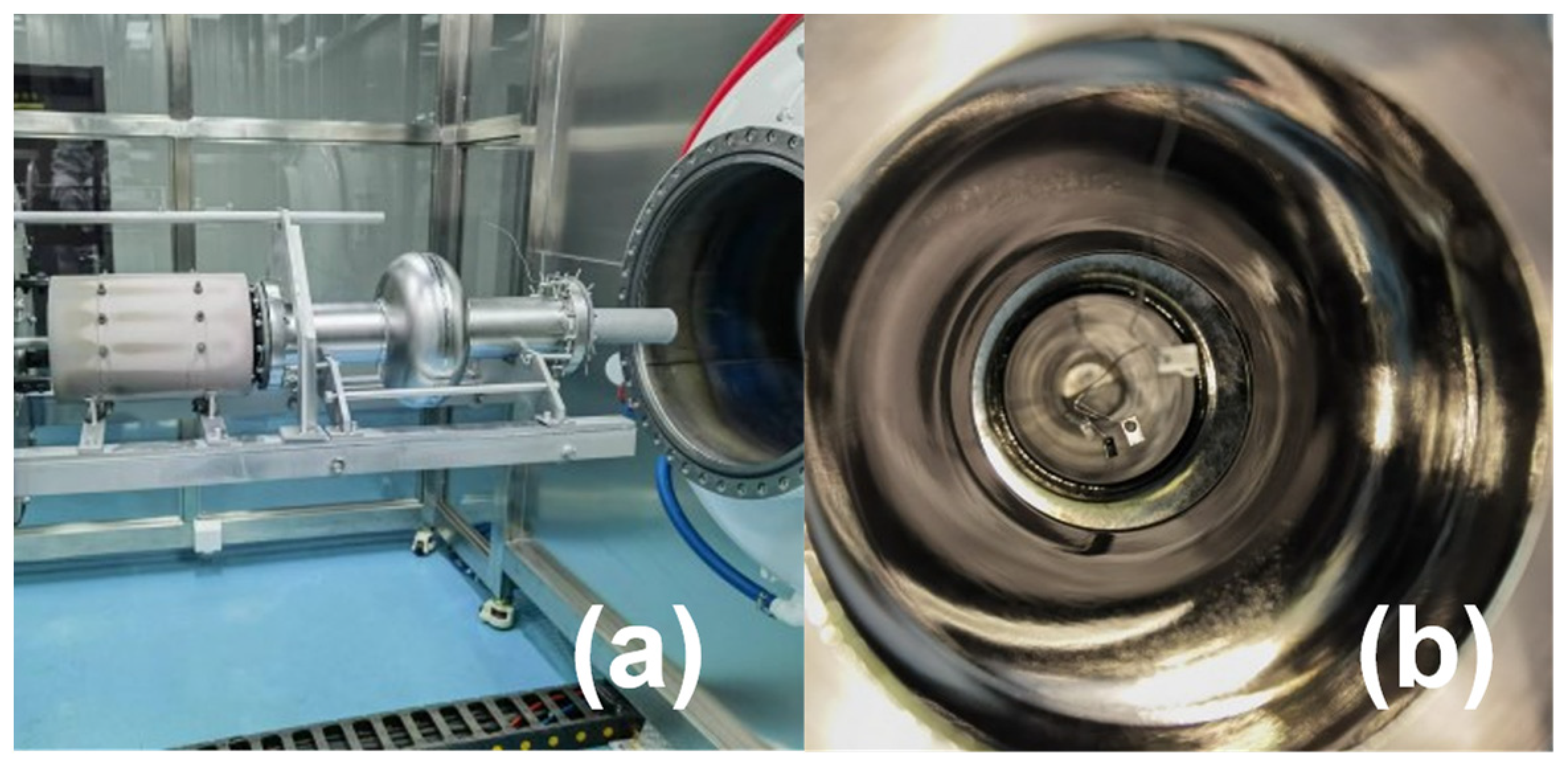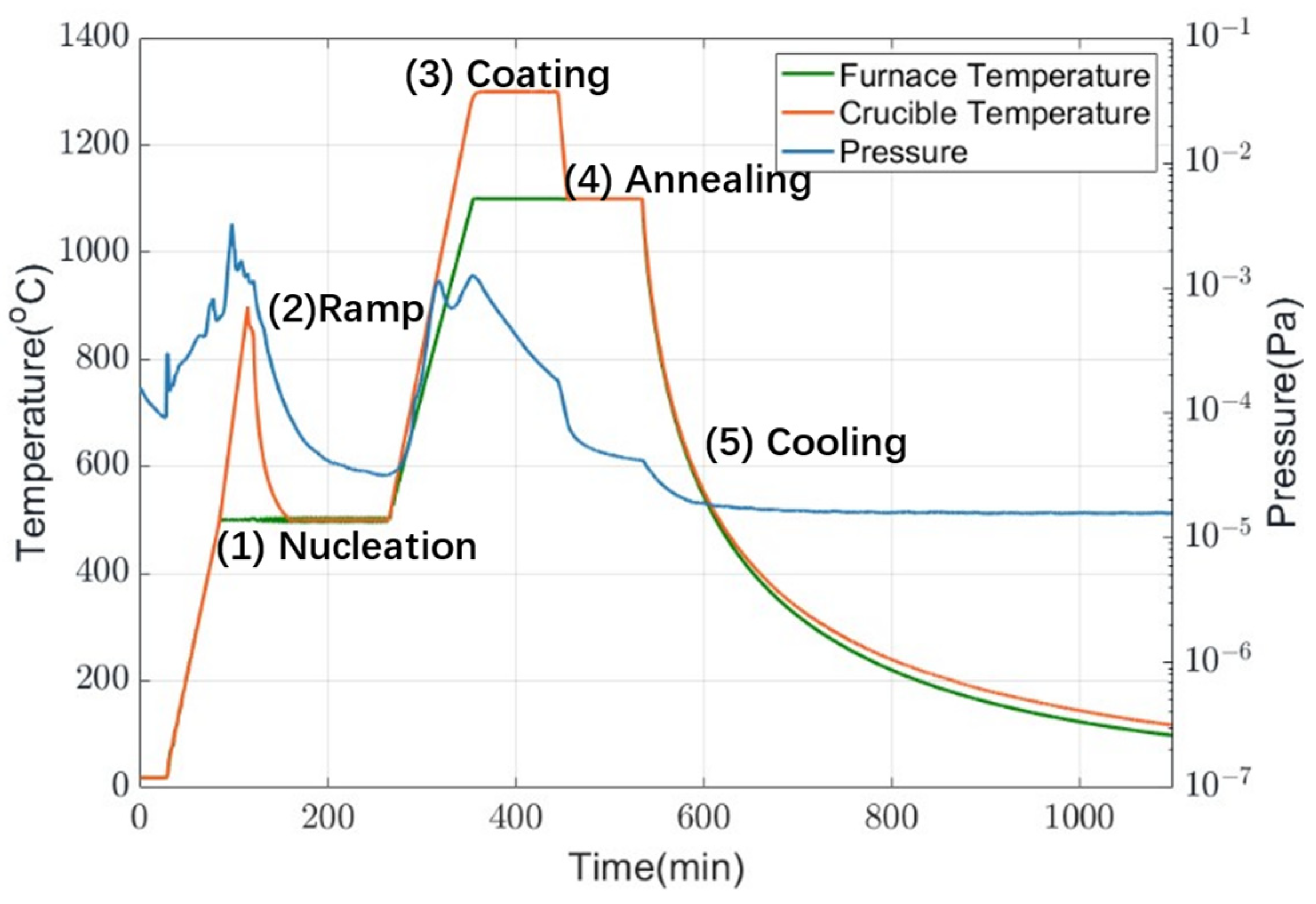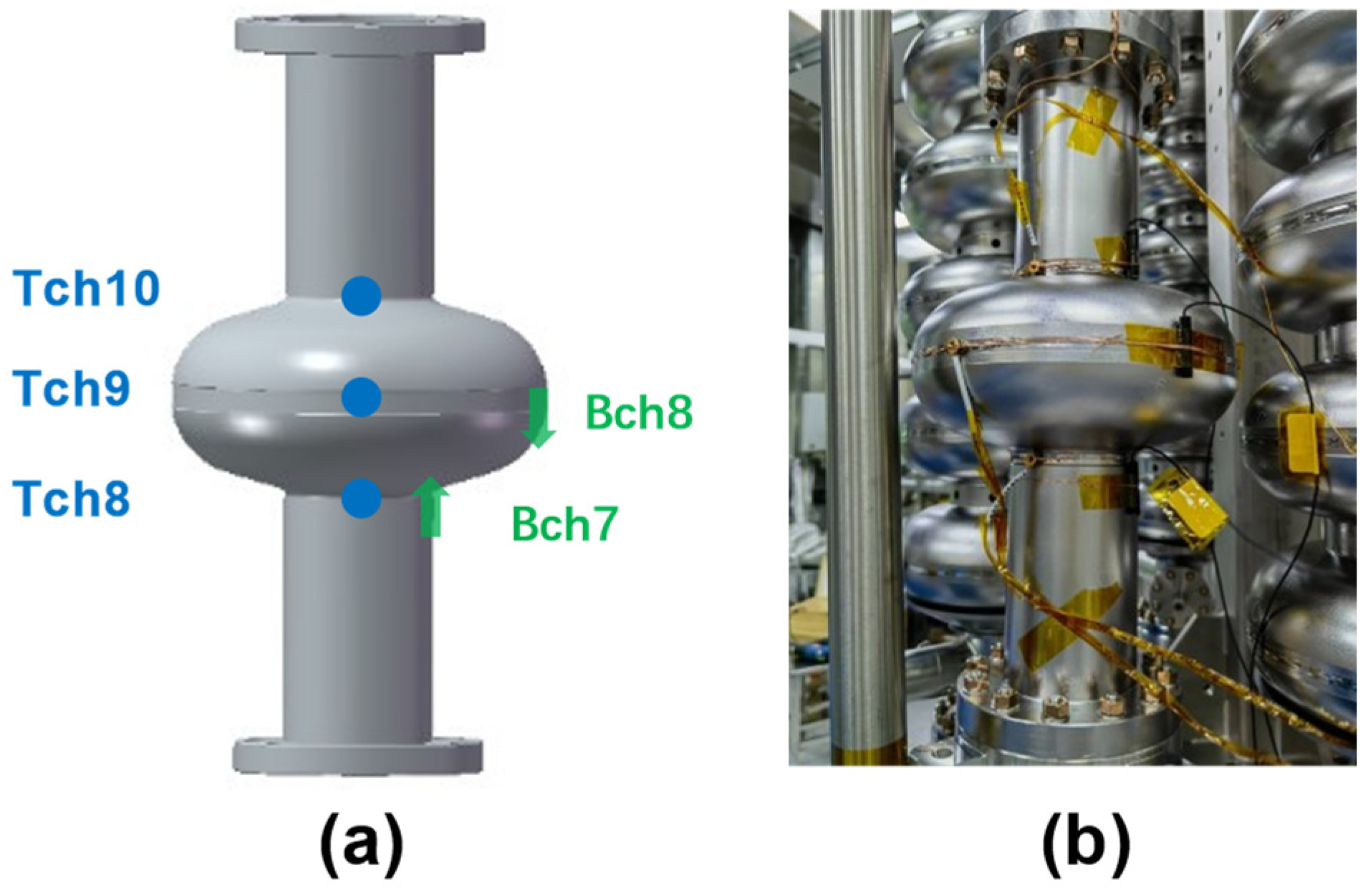First Results of Nb3Sn Coated Cavity by Vapor Diffusion Method at SARI
Abstract
:1. Introduction
2. Experiment
2.1. Research Method
2.2. Preparation of the Coated Cavities
2.3. Coating Description
3. Results
3.1. Vertical Test of the Coated Cavity
3.2. Sample Analysis
4. Discussion
5. Conclusions
Author Contributions
Funding
Institutional Review Board Statement
Informed Consent Statement
Data Availability Statement
Conflicts of Interest
References
- Reece, C.E. Continuous Wave Superconducting Radio Frequency Electron Linac for Nuclear Physics Research. Phys. Rev. Accel. Beams 2016, 19, 124801. [Google Scholar] [CrossRef]
- Brachmann, A.; Dunham, M.; Schmerge, J.F. LCLS-II: Status and upgrades. In Proceedings of the 39th International Free Electron Laser Conference (FEL2019), Hamburg, Germany, 26–30 August 2019; pp. 772–775, FRA02. [Google Scholar] [CrossRef]
- Altarelli, M. (Ed.) XFEL, the European X-ray Free-Electron Laser: Technical Design Report; DESY XFEL Project Group [u.a.]: Hamburg, Germany, 2006; ISBN 978-3-935702-17-1. [Google Scholar]
- Liu, B. Progress of shanghai high repetation rate XFEL and extreme light facility. In Proceedings of the LINAC2022, Liverpool, UK, 28 August–2 September 2022; p. TU1AA05. [Google Scholar]
- Posen, S.; Hall, D.L. Nb3Sn Superconducting Radiofrequency Cavities: Fabrication, Results, Properties, and Prospects. Supercond. Sci. Technol. 2017, 30, 033004. [Google Scholar] [CrossRef]
- Catelani, G.; Sethna, J.P. Temperature Dependence of the Superheating Field for Superconductors in the High-κ London Limit. Phys. Rev. B 2008, 78, 224509. [Google Scholar] [CrossRef]
- Matricon, J.; Saint-James, D. Superheating Fields in Superconductors. Phys. Lett. A 1967, 24, 241–242. [Google Scholar] [CrossRef]
- Padamsee, H. 50 Years of Success for SRF Accelerators—A Review. Supercond. Sci. Technol. 2017, 30, 053003. [Google Scholar] [CrossRef]
- Mason, T.E.; Abernathy, D.; Anderson, I.; Ankner, J.; Egami, T.; Ehlers, G.; Ekkebus, A.; Granroth, G.; Hagen, M.; Herwig, K.; et al. The Spallation Neutron Source in Oak Ridge: A Powerful Tool for Materials Research. Phys. B Condens. Matter 2006, 385–386, 955–960. [Google Scholar] [CrossRef]
- Zong, Y.; Chen, J.F.; Wang, D.; Chen, Q.X.; Chen, Z.X.; Cheng, C.H.; Dong, P.C.; Hou, H.T.; Huang, X.; Huang, Y.W.; et al. Accelerating Gradient Improvement in Nitrogen-Doped Superconducting Radio-Frequency Cavities for SHINE. Nucl. Instrum. Methods Phys. Res. Sect. A Accel. Spectrometers Detect. Assoc. Equip. 2023, 1057, 168724. [Google Scholar] [CrossRef]
- Kneisel, P. Preliminary experience with in-situ baking of niobium cavities. In Proceedings of the 9th Workshop on RF Superconductivity, Santa Fe, NM, USA, 1–5 November 1999; pp. 328–335. [Google Scholar]
- Sha, P.; Pan, W.-M.; Jin, S.; Zhai, J.-Y.; Mi, Z.-H.; Liu, B.-Q.; Dong, C.; He, F.-S.; Ge, R.; Sun, L.-R.; et al. Ultrahigh Accelerating Gradient and Quality Factor of CEPC 650 MHz Superconducting Radio-Frequency Cavity. Nucl. Sci. Tech. 2022, 33, 125. [Google Scholar] [CrossRef]
- Grassellino, A.; Romanenko, A.; Trenikhina, Y.; Checchin, M.; Martinello, M.; Melnychuk, O.S.; Chandrasekaran, S.; Sergatskov, D.A.; Posen, S.; Crawford, A.C.; et al. Unprecedented Quality Factors at Accelerating Gradients up to 45 MVm−1 in Niobium Superconducting Resonators via Low Temperature Nitrogen Infusion. Supercond. Sci. Technol. 2017, 30, 094004. [Google Scholar] [CrossRef]
- Yamamoto, A. The Future of Superconducting Technology for Accelerators. In Proceedings of the IPAC 2017, Copenhagen, Denmark, 14–19 May 2017; Volume 5, pp. 19–23. [Google Scholar]
- Reece, C.E.; Ciovati, G. Superconducting Radio-Frequency Technology R&D for Future Accelerator Applications. Rev. Accl. Sci. Technol. 2012, 5, 285–312. [Google Scholar] [CrossRef]
- Valente-Feliciano, A.-M. Superconducting RF Materials Other than Bulk Niobium: A Review. Supercond. Sci. Technol. 2016, 29, 113002. [Google Scholar] [CrossRef]
- Schneider, W.J.; Kneisel, P.; Rode, C.H. Gradient Optimization for SC CW Accelerators. In Proceedings of the 2003 Bipolar/BiCMOS Circuits and Technology Meeting (IEEE Cat. No.03CH37440), Toulouse, France, 28–30 September 2003; IEEE: Portland, OR, USA, 2003; Volume 5, pp. 2863–2865. [Google Scholar]
- Posen, S. Understanding and Overcoming Limitation Mechanisms in Nb3Sn Superconducting RF Cavities. Ph.D. Thesis, Cornell University, Ithaca, NY, USA, 2015. [Google Scholar]
- Becker, C.; Posen, S.; Groll, N.; Cook, R.; Schlepütz, C.M.; Hall, D.L.; Liepe, M.; Pellin, M.; Zasadzinski, J.; Proslier, T. Analysis of Nb3Sn Surface Layers for Superconducting Radio Frequency Cavity Applications. Appl. Phys. Lett. 2015, 106, 082602. [Google Scholar] [CrossRef]
- Ilyina, E.A.; Rosaz, G.; Descarrega, J.B.; Vollenberg, W.; Lunt, A.J.G.; Leaux, F.; Calatroni, S.; Venturini-Delsolaro, W.; Taborelli, M. Development of Sputtered Nb3Sn Films on Copper Substrates for Superconducting Radiofrequency Applications. Supercond. Sci. Technol. 2019, 32, 035002. [Google Scholar] [CrossRef]
- Zhu, L.; Lu, X.; Yang, Z.; Tan, W.; Yang, Y.; Xiao, L.; Xie, D. Study on Preparation of Nb3Sn Films by Bronze Route. Phys. C Supercond. Its Appl. 2022, 601, 1354113. [Google Scholar] [CrossRef]
- Sun, Z.; Baraissov, Z.; Porter, R.D.; Shpani, L.; Shao, Y.-T.; Oseroff, T.; Thompson, M.O.; Muller, D.A.; Liepe, M.U. Smooth, Homogeneous, High-Purity Nb3Sn Superconducting RF Resonant Cavity by Seed-Free Electrochemical Synthesis. Supercond. Sci. Technol. 2023, 36, 115003. [Google Scholar] [CrossRef]
- Kosky, P.G.; Peters, H.C.; Spiro, C.L.; McAtee, D.S.; Rumaner, L.; Marsh, D. Superconducting Nb3Sn Joints by Chemical Vapour Deposition. Cryogenics 1994, 34, 753–759. [Google Scholar] [CrossRef]
- Matthias, B.T.; Geballe, T.H.; Geller, S.; Corenzwit, E. Superconductivity of Nb3Sn. Phys. Rev. 1954, 95, 1435. [Google Scholar] [CrossRef]
- Saur, E.; Wurm, J. Preparation und Supraleitungseigenschaften von Niobdrahtproben mit Nb3Sn-Uberzug. Naturwissenschaften 1962, 49, 127–128. [Google Scholar] [CrossRef]
- Hillenbrand, B.; Martens, H. Superconducting Nb3Sn Cavities with High Quality Factors and High Critical Flux Densities. J. Appl. Phys. 1976, 47, 4151–4155. [Google Scholar] [CrossRef]
- Pudasaini, U.; Kelley, M.; Eremeev, G.; Reece, C. Nb3Sn Multicell Cavity Coating at JLAB. In Proceedings of the IPAC 2018, Vancouver, BC, Canada, 29 April–4 May 2018; US DOE: Washington, DC, USA, 2018. [Google Scholar] [CrossRef]
- Posen, S.; Lee, J.; Seidman, D.N.; Romanenko, A.; Tennis, B.; Melnychuk, O.S.; Sergatskov, D.A. Advances in Nb3Sn Superconducting Radiofrequency Cavities towards First Practical Accelerator Applications. Supercond. Sci. Technol. 2021, 34, 025007. [Google Scholar] [CrossRef]
- Takahashi, K.; Ito, H.; Kako, E.; Konomi, T.; Okada, T.; Sakai, H.; Umemori, K. First Nb3Sn Coating and Cavity Performance Result at KEK. In Proceedings of the 20th International Conference on RF Superconductivity, East Lansing, MI, USA, 28 June–2 July 2021; pp. 27–31, SRF2021. [Google Scholar] [CrossRef]
- Wang, G.; Quan, S.; Lin, L.; Ren, M.; Hao, J.; Wang, F.; Jiao, F.; Zhu, F.; Huang, S.; Yan, X.; et al. Nb3Sn Cavities Coated by Tin Vapor Diffusion Method at Peking University. Appl. Sci. 2023, 13, 8618. [Google Scholar] [CrossRef]
- Yang, Z.; Huang, S.; He, Y.; Lu, X.; Guo, H.; Li, C.; Niu, X.; Xiong, P.; Song, Y.; Wu, A.; et al. Low-Temperature Baking Effect of the Radio-Frequency Nb3Sn Thin Film Superconducting Cavity. Chin. Phys. Lett. 2021, 38, 092901. [Google Scholar] [CrossRef]
- Dong, C.; Lin, Z.; Sha, P.; Liu, B.; Ye, L.; He, X. Preliminary Research of Niobium Cavity Coating with Nb3Sn Film at IHEP. Phys. C Supercond. Its Appl. 2022, 600, 1354107. [Google Scholar] [CrossRef]
- Lee, J.; Posen, S.; Mao, Z.; Trenikhina, Y.; He, K.; Hall, D.L.; Liepe, M.; Seidman, D.N. Atomic-Scale Analyses of Nb3Sn on Nb Prepared by Vapor Diffusion for Superconducting Radiofrequency Cavity Applications: A Correlative Study. Supercond. Sci. Technol. 2019, 32, 024001. [Google Scholar] [CrossRef]
- Chen, Q.X.; Zong, Y.; Chen, J.F.; Xing, S.; Rong, J. Nb3Sn Vapor Diffusion Coating System at SARI: Design, Construction, and Commissioning. In Proceedings of the 21th International Conference on RF Superconductivity 2023, Grand Rapids, MI, USA, 25–30 June 2023; pp. 655–657, SRF2023. [Google Scholar] [CrossRef]
- Grassellino, A.; Romanenko, A.; Crawford, A.; Melnychuk, O.; Rowe, A.; Wong, M.; Sergatskov, D.; Bice, D.; Trenikhina, Y.; Cooley, L.D.; et al. Fermilab Experience of Post-Annealing Losses in SRF Niobium Cavities Due to Furnace Contamination and the Ways to Its Mitigation: A Pathway to Processing Simplification and Quality Factor Improvement. Available online: https://doi.org/10.48550/arXiv.1305.2182 (accessed on 9 May 2013).
- Jiang, G.; Wu, S.; Yang, Z.; He, Y.; Ye, Y.; Guo, H.; Li, C.; Xiong, P.; Li, L.; Huang, S.; et al. Understanding and Optimization of the Coating Process of the Radio-Frequency Nb3Sn Thin Film Superconducting Cavities Using Tin Vapor Diffusion Method. Appl. Surf. Sci. 2024, 643, 158708. [Google Scholar] [CrossRef]
- Godeke, A. A Review of the Properties of Nb3Sn and Their Variation with A15 Composition, Morphology and Strain State. Supercond. Sci. Technol. 2006, 19, R68–R80. [Google Scholar] [CrossRef]

















| Parameters | Furnace | Coating Chamber |
|---|---|---|
| Maximum temperature | ≥1300 °C | |
| Heating rate | ≥720 °C/h | |
| Temperature uniformity | <±4 °C | |
| Effective heating zone | Ø600 mm × 1000 mm | Ø300 mm × 600 mm |
| Target vacuum pressure | <8 × 10−5 Pa (25 °C) | <2 × 10−5 Pa (25 °C) |
| <2 × 10−3 Pa (1100 °C) | <3 × 10−4 Pa (1200 °C) | |
| Position | 1 | 2 | 3 |
|---|---|---|---|
| Sn content (at. %) | 25.90% | 25.69% | 25.98% |
| Average Sn content | 25.86% | ||
Disclaimer/Publisher’s Note: The statements, opinions and data contained in all publications are solely those of the individual author(s) and contributor(s) and not of MDPI and/or the editor(s). MDPI and/or the editor(s) disclaim responsibility for any injury to people or property resulting from any ideas, methods, instructions or products referred to in the content. |
© 2024 by the authors. Licensee MDPI, Basel, Switzerland. This article is an open access article distributed under the terms and conditions of the Creative Commons Attribution (CC BY) license (https://creativecommons.org/licenses/by/4.0/).
Share and Cite
Chen, Q.; Zong, Y.; Wang, Z.; Xing, S.; Wu, J.; Dong, P.; Zhao, M.; Wu, X.; Rong, J.; Chen, J. First Results of Nb3Sn Coated Cavity by Vapor Diffusion Method at SARI. Coatings 2024, 14, 581. https://doi.org/10.3390/coatings14050581
Chen Q, Zong Y, Wang Z, Xing S, Wu J, Dong P, Zhao M, Wu X, Rong J, Chen J. First Results of Nb3Sn Coated Cavity by Vapor Diffusion Method at SARI. Coatings. 2024; 14(5):581. https://doi.org/10.3390/coatings14050581
Chicago/Turabian StyleChen, Qixin, Yue Zong, Zheng Wang, Shuai Xing, Jiani Wu, Pengcheng Dong, Miyimin Zhao, Xiaowei Wu, Jian Rong, and Jinfang Chen. 2024. "First Results of Nb3Sn Coated Cavity by Vapor Diffusion Method at SARI" Coatings 14, no. 5: 581. https://doi.org/10.3390/coatings14050581






